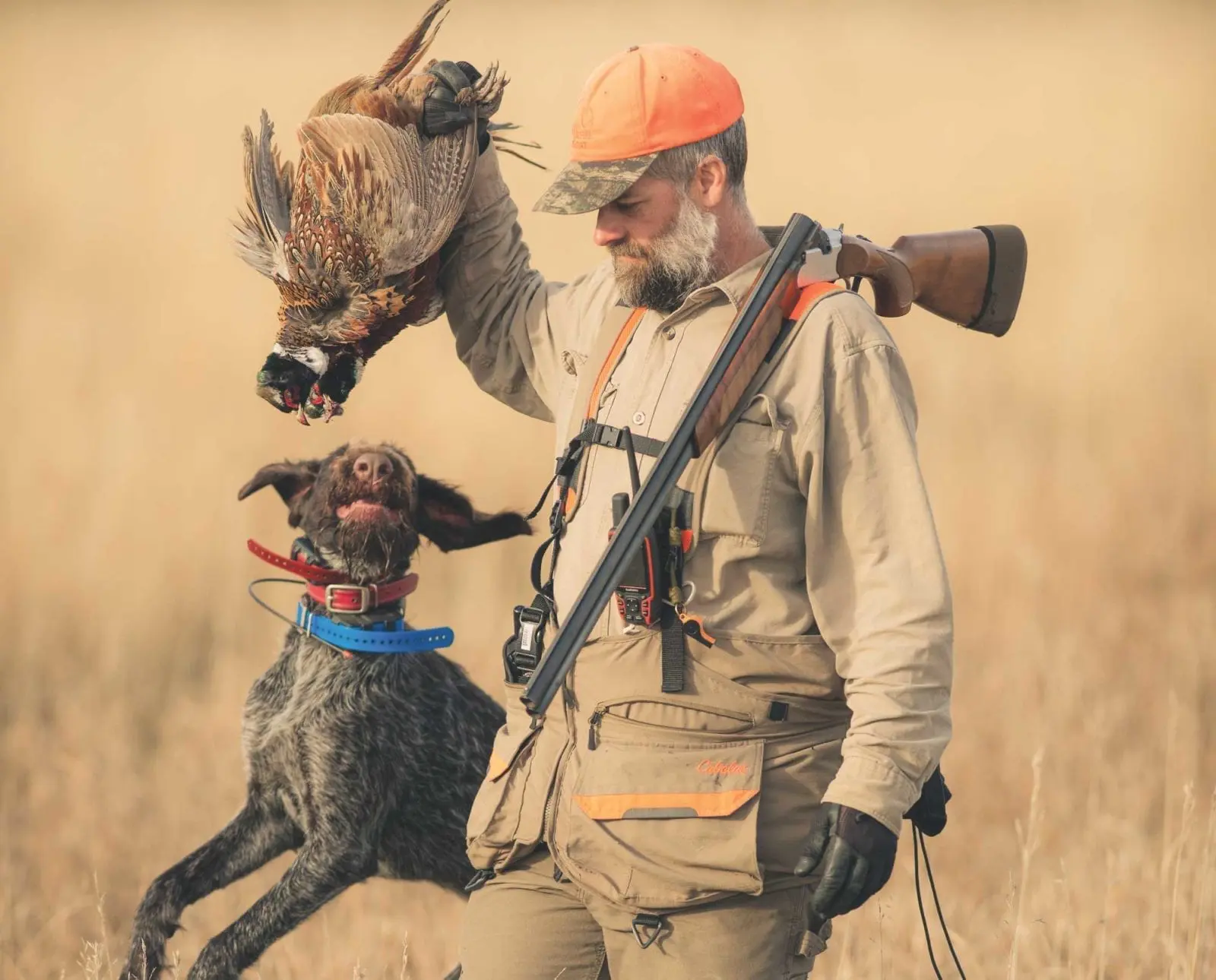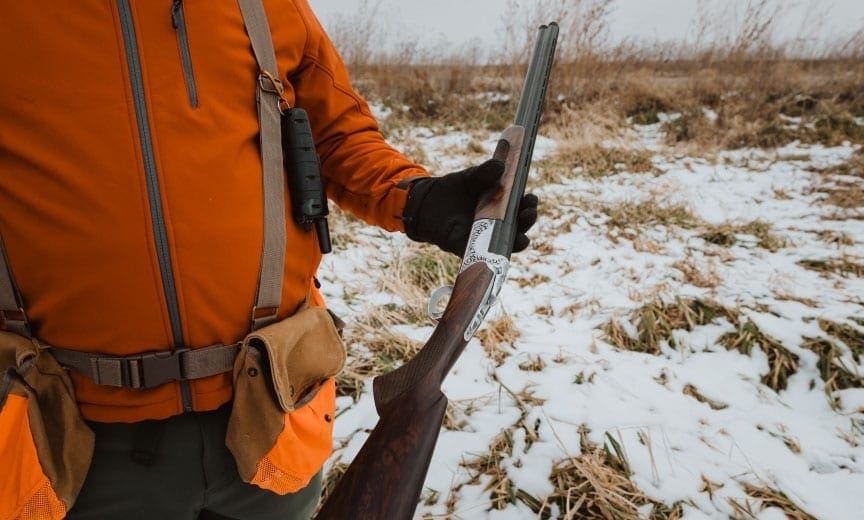Home » Pheasant Hunting » Choosing the Best Length Barrel for Pheasant Hunting
Choosing the Best Length Barrel for Pheasant Hunting

A life-long hunting, shooting and motorsports enthusiast, Zachary Hein grew…
Having a tough time choosing a barrel length on your shotgun for pheasant? Here are some answers.
When it comes down to it, if you’re in the market for a break-open shotgun specifically for wild pheasants, I’d point you towards one with a 28 inch barrel. There are absolutely caveats to that, so if you want to dive a little deeper on the topic, read on.
To back up a little, a query for the perfect barrel length for ring-necked pheasant shares the same answer as a similar question, “What is the best shotgun for (insert upland bird here)?” The answer to both is simple – whatever shotgun you shoot the most and shoot best, which in an ideal world would be one and the same. Nearly any shotgun will do the job, but none will do it as well as the gun you know and shoot well.
READ: Upland Shotguns – Which is right for bird hunting?
Sadly, that answer is riddled with issues. Maybe you don’t own a shotgun, own too many shotguns to have a single go-to, or own one shotgun and can’t hit the broad side of a barn with it. It’s possible the gun you shoot the most/best is a boat anchor of a sporting clays gun with 32 inch ported barrels and all sorts of adjustable stock hardware. Or maybe it’s a Snake Charmer in .410.
Shotgun Design
Distilled to their core, modern break-open shotguns can fairly easily be split into two main categories – ‘field’ and ‘target.’ It’s not a perfect line between the two, but field guns tend to be lighter and simpler whereas target guns incorporate adjustability while adding features and weight to ease the burden of shooting hundreds of rounds in a day.
Though hardly a rule and with notable exceptions, field guns tend to have shorter barrels while target guns have longer barrels. When looking at new production shotguns, there are options with barrel lengths from 18 to 36 inch and everything in between.
When picking a gun for wild roosters, I would absolutely choose one designed as a field gun. An adjustable comb is wonderful for fine-tuning fit, ports kill a bit of recoil and a high rib is great for target visibility, but the last thing I want to do is have a set screw come loose and lose my comb in deep CRP, (further) deafen my dog or bend a fragile, high-dollar rib jumping out of the truck to ambush a ditch chicken.
For me, the simplicity of a field gun is a necessity.
READ: Pheasant Hunting Ammo and Chokes – A Pheasant Hunters Guide
Shotgun Weight
Longer barrels bring a bit more weight, and too long can mean too heavy. With Midwest pheasant populations not quite what they were several decades ago, a day in the field can mean putting down a surprising number of miles chasing a wild bird limit. The heavier the shotgun, the more tired the hunter.
Also affecting weight will be the style of mid-rib, with full, partial, vented and skeletonized styles available. Gauge plays into it as well, with larger 12-gauge frames, monoblocks and barrels resulting in more weight than a similarly-designed 20 or 28. Extended chokes can add a small amount as well, and at the end of the barrel which has a greater influence on swing than the same amount of weight at the center of the gun.

How the Shotgun Swings
Besides tiring you out, the weight of a shotgun and where that weight is distributed has a direct effect on how the gun swings. A shotgun with evenly-distributed weight can feel tremendously different than one that has centralized mass or one that is extremely muzzle-heavy. Given the same overall weight, a muzzle-heavy gun could feel cumbersome compared to one that’s more evenly balanced.
That said, shorter-barreled field guns tend to be quick on target at the expense of being a bit ‘whippy.’ With a nimble, rapidly-accelerating bird like quail, 24 and 26 inch barrels are incredibly fast and also snag less in brambles and brush, but can easily be over-driven if the quarry isn’t a particularly quick one.
Longer barrels swing more deliberately due to the added weight in general, but specifically the extra ounces out front. For wild pheasants that prefer prairies, snagging in brambles and getting blocked by trees isn’t nearly the issue it is in the grouse woods, so the longer barrels won’t be a detriment in that regard.
READ: How to Choose a Shotgun for Pheasant Hunting
Pheasants are a big bird and while they can launch themselves from hiding with surprising speed, their ability to accelerate is much different than that of a quail. Not a sprinter, once they get a head of steam they’re still blisteringly fast. Add in a roaring Kansas wind and they’ll embarrass the most experienced wingshooter – whereas a bobwhite can quickly get to 40 mph, a pheasant will clock a solid 60.
The bigger difference between these grassland birds is their typical trajectory. While a quail is a master of diversion and might skim the top of cover, diving side to side and seemingly corkscrewing to avoid incoming shot, a pheasant is on a mission to put distance between it and you. A predictable arc is to be expected, so the shotgun doesn’t need to be short and nimble so much as it needs to have a smooth and deliberate swing.
It’s my experience that a shooter of average stature would be well-served by a field gun equipped with 28 inch barrels when chasing pheasants. They’re long enough to be smooth-swinging and light enough to not be exhausting.
Like so many things, in the end it comes down to personal preference and what feels right. Smaller-statured shooters might need a lighter/shorter gun, while those who tower over the rest of us like my friend Bobby will opt for a 30 inch, even in the grouse woods.
Far more important than barrel length is fit – if a shotgun doesn’t automatically point where your eye is looking when you put it up, you’re tying one arm behind your back before you step into the field. But that’s a whole different discussion.
A life-long hunting, shooting and motorsports enthusiast, Zachary Hein grew up on the plains of western Kansas chasing pheasants, quail and deer. Still based in the sunflower state, he works in marketing for CZ-USA and tours the midwest and beyond with his motley menagerie of mutts and a small fleet of overland-equipped Toyotas.




Two of my favorite upland guns – Browning Citori 20 gauge married to Fiochii Nickel Plated 2 3/4 high brass 6s and the 12 gauge Benelli Montrefeltro for those cold and windy days in field.
I hunt pheasants approximately 35 days per year over Springer Spaniels and switched to a Browning Citori 20Ga with a 26” barrel over 25 yrs ago…. lighter, fast swinging and more compact than my 12GA 28”. In late season I use Prairie Storm 3” shells to add muscle to the smaller gun.
No comparison between the smaller, lighter, faster swinging gun when your next bird flushes 8 miles from your previous bird!
What makes you think you will further deafen your gun dog by adding ports? It’s not making the gun louder. It’s changing the direction of the blast. In return would be better for your dogs hearing. Seeing your dog in in front of you at most time and not above you. guns without ported barrel would be doing more harm to dog then guns with.
So ported guns create more noise as one of the trade-offs for reducing recoil and/or muzzle climb, and they also throw the blast in a much wider arc when compared to a non-ported barrel. Those next to you when you fire will take the brunt of it, dogs included. It doesn’t just throw that noise up — though it would be nice if it did.